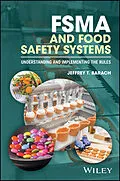The FDA's (Food and Drug Administration) FSMA (Food Safety Modernization Act) is the most sweeping reform of United States food safety laws in more than 70 years. The key to successful implementation of FSMA rules depends on building a comprehensive Food Safety System with effective prerequisite programs in place and a well-designed Food Safety Plan that incorporates risk-based preventive controls to mitigate hazards. This book provides essential guidance for small to mid-sized businesses on how to design, implement, and maintain a world-class Food Safety Plan that conforms to FSMA regulations. With practical and up-to-date advice, the author offers a straight forward approach for readers to successfully migrate into FSMA. The inclusion of fully developed Food Safety Plans as well as examples of hazards and preventative controls make this a must-read not only for those that are new to the regulations, but also those with a plan already in place. FSMA and Food Safety Systems: A Guide to Understanding and Implementing the Rules is an indispensable resource for all those managing the manufacture of FDA regulated products, food safety regulators and educators, as well as scientists and students of food science and technology.
Autorentext
Jeffrey T. Barach, PhD, Barach Enterprises LLC, Virginia, US
Dr Barach is responsible for forming, initiating programs and setting direction for this technical consulting firm focused on a mission of providing technical services, influencing policy issues and building the scientific, technical and regulatory strength of the food industry through stewardship, training and education programs.
Inhalt
Preface xi
About the Author xiii
1 What is Modern Food Safety, and How is that Different from HACCP? 1
1.1 Introduction 1
1.2 FSMA Sanitation and cGMPs 3
1.3 FSMA Preventive Controls 4
1.4 Process Controls 5
1.5 Sanitation Controls 6
1.6 Supplier Controls 8
References 10
2 Why is a Food Safety System the Best Path to Food Safety? 11
2.1 What are Biological Hazards and Their Controls? 11
2.2 What are Chemical Hazards, Including Allergens and Radioactivity, and Their Controls? 15
2.3 What are Physical Hazards and Their Controls? 17
References 19
3 What are the Essential Elements of a Food Safety System? 21
3.1 What are Prerequisite Programs, and What Do They Do? 22
3.2 What is a Hazard Analysis, and Why is it Performed? 23
3.3 What are Risk-Based Preventive Controls, and How are they Assigned? 25
3.3.1 What Controls are used to Control Allergen-Related Hazards? 26
3.3.2 What Controls are used to Control Sanitation-Related Hazards? 27
3.3.3 What Controls are used to Control Process Hazards? 29
3.3.4 What Controls are used to Control Supplier-Related Hazards? 30
3.4 What is a Food Safety Plan, and Who Develops It? 32
4 How is a Food Safety System Managed? 35
4.1 What is the Role of Management and Plant Operations in a Food Safety System? 35
4.2 How are SOPs Developed and Managed? 36
4.3 How are Preventive Controls Managed? 39
4.3.1 What are Performance Criteria for Controls, Including Critical Limits? 39
4.3.2 How are Preventive Controls Monitored? 40
4.3.3 If Preventive Controls Fail, What Corrective Actions are Needed? 41
4.3.4 How is the System and its Parts Verified as Being Compliant? 43
4.3.5 How are Process Preventive Controls Validated? 44
4.4 How are Records Established and Maintained? 46
4.5 Why and How is a Recall Plan Developed and Managed? 48
References 51
Supplemental References for Recalls 51
5 How is a Food Safety System Developed and Implemented? 53
5.1 Developing a Food Safety Plan 54
5.2 Assemble the Food Safety Team 55
5.3 Describe the Food and its Distribution 55
5.4 Describe the Intended Use and Consumers of the Food 55
5.5 Develop a Flow Diagram that Describes the Process 56
5.6 Verify the Flow Diagram 56
5.7 Conduct a Hazard Analysis 56
5.8 Essential Elements of the Food Safety Plan 58
6 What Triggers a Reanalysis of the Food Safety Plan? 61
7 Resources for Preparing Food Safety Preventive Controls Plans 63
7.1 Examples of Prerequisite Programs 63
7.2 Examples of Allergen Preventive Controls 65
7.3 Examples of Sanitation Preventive Controls 65
7.4 Examples of Process Preventive Controls 66
7.5 Examples of Supplier Controls 68
7.6 Useful Forms 68
7.7 FSMA Training and the Food Safety Preventive Controls Alliance 75
8 Example Food Safety Plans 77
Barbeque Sauce Example Food Safety Plan 78
Company Overview 78
Process Narrative 79
Chocolate Chip Walnut Cookies Example Food Safety Plan 88
Company Overview 88
Process Narrative 89
Deli Potato Salad Example Food Safety Plan 102
Company Overview 102
Process Narrative 103
Macaroni & Cheese Frozen Meal Example Food Safety Plan 118
Company Overview 118
Process Narrative 119
9 FSMA Regulations: cGMPs, Hazard Analysis, and Risk-Based Preventive Controls for Human Foods 131
FDA Regulations on cGMP's, Hazard Analysis and Risk-based Preventive Controls for Human Foods 132
Part 117Current Good Manufacturing Practice, Hazard Analysis, and RiskBased Preventive Controls for Human Food 132
Subpart AGeneral Provisions 132
Su...
